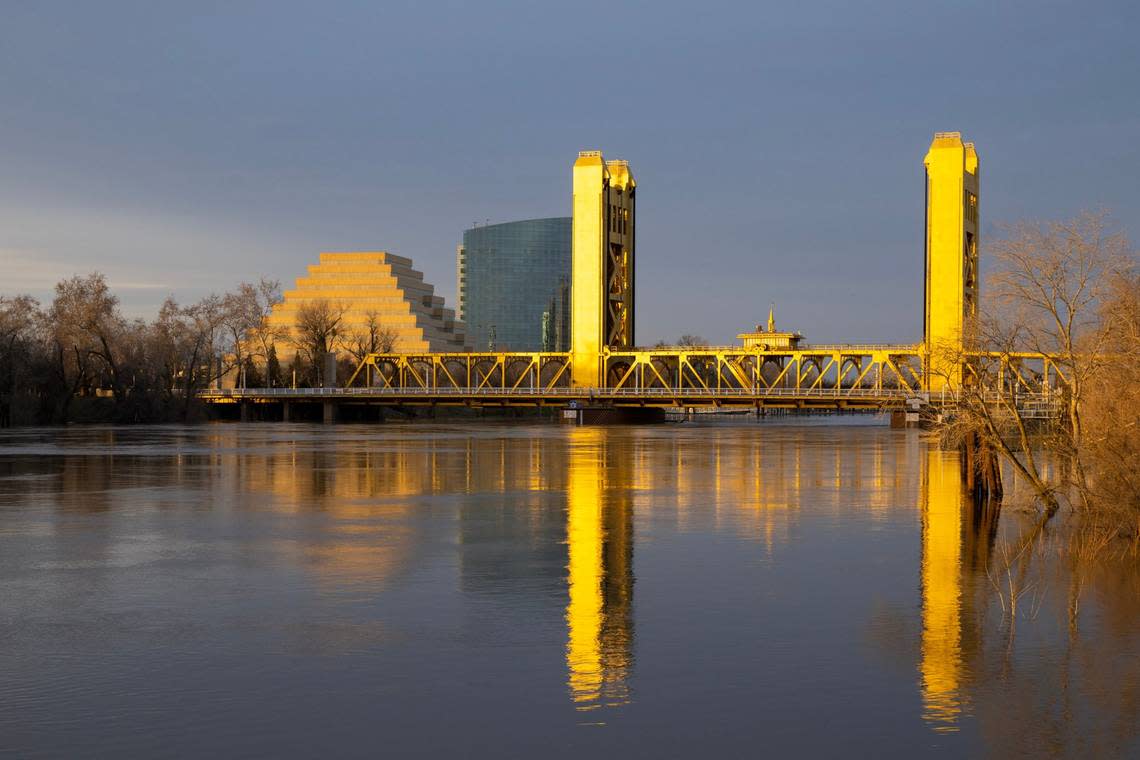Where is there evidence of New Deal project in Sacramento? Think Tower Bridge for starters

The Tower Bridge stands as a landmark for Sacramento, but it also represents our nation’s resolve to overcome the Great Depression.
This yellow bridge that spans the Sacramento River was among the early projects completed under President Franklin D. Roosevelt’s New Deal.
The Tower Bridge is just one of many New Deal remnants that can be found around Sacramento. Those who want to learn more about the projects associated with the 1930s era programs and reforms have an opportunity to do so with the arrival of the traveling Smithsonian exhibit “The Way We Worked” at Central Library. The display will be up through July 22 and includes five presentations by local scholars.
UC Davis history professor Eric Rauchway kicked off the exhibit, that opened Saturday, with a discussion titled “Why the New Deal Matters,” which included details on the bridge’s mid-1930s construction. He said the idea to replace Sacramento’s old M Street Bridge, at a cost of $360 million in today’s dollars and with the labor of 1,500 workers, wasn’t new.
“They were ideas that had been kicking around, but then were given a spurt, if you like, by New Deal spending,” Rauchway said.
James Scott, an archivist at Central Library’s Sacramento Room helped set up the exhibit, which consists of several color placards in the library’s first-floor lobby and spans 150 years of labor history. Scott also assembled the speaker series, recruiting Rauchway after listening to a book he wrote with the same title as his presentation.
“The New Deal is one of those things that’s everywhere in our world,” Scott said in introductory remarks for Rauchway’s presentation, which was held adjacent to the lobby in the Library Galleria West Meeting Room. “But you rarely know it just by hanging out.”
Rauchway, during his presentation, offered details about how the bridge was put out for bid on June 19, 1934, with George Pollock’s winning bid coming in at around $907,000. Construction began two months later and finished in December 1935, a dizzyingly fast pace by today’s standards where a new stretch of freeway can take years, if not more than a decade to complete.
What other New Deal projects can we see?
Local examples of New Deal projects abound, Rauchway noted. McClatchy High School, which opened in 1937, was a Works Progress Administration project, as was Land Park’s WPA Rock Garden. Sidewalks stamped “WPA” with a year from the 1930s can also still be found around the city.
“If you think about sidewalks, if you think about parks, if you think about public libraries, all of which are sort of hallmarks of the New Deal, you begin to have a sense of what the New Deal work is doing,” Rauchway said.
Some of the people who attended Rauchway’s talk could speak to this, such as Mahlon Picht, 87, who grew up in Land Park and lives in the neighborhood today. As Rauchway and audience members named different local New Deal projects, Picht mentioned the auditorium at California Middle School.
This auditorium was originally built for what was then Crocker Elementary School, Picht explained later. He added that Sacramento City College’s auditorium was also a New Deal project, with a WPA mural still in the foyer.
Picht enjoyed the library event, saying afterward that he appreciated both Rauchway’s presentation and how he responded to questions. Picht’s friend Jay Rudin, who is the son of the first woman to be elected mayor of Sacramento, the late Anne Rudin, also liked what Rauchway had to say.
“I’m already aware of the WPA projects, but I was happy that it was a lot more about what was going on then,” Rudin said.
Rauchway captured how the New Deal was far from just public works projects, but also an investment in public art, film, infrastructure and much more. Andrew Chandar, one of a few Sacramento Public Library workers to take in at least some of Rauchway’s presentation said his favorite part was “the ripple effect that he presented” for everything from housing to the great migration.
The exhibit that opened the same day as Rauchway’s talk comes through the Smithsonian Institution Traveling Exhibition Service at a cost of about $8,000, including what the library will spend to ship the exhibit to its next stop in Michigan. It’s part of an effort by Scott and other library staff to rebuild attendance post-pandemic.
“The exhibit thing is relatively new,” Scott said. “I mean, a lot of that ties into the fact that we now have pretty unrestricted funds from our foundation. So anything that adds to the historical body of knowledge, we can sort of bring in.”
Upcoming presentations in this series
▪ “Organized Labor in Pre-WWII Sacramento,” by historian William Burg, 1 p.m. May 6
▪ “Sacramento and the 2nd Great Migration,” by Sacramento African American Experience Project principal historian Damany Fisher, 1 p.m. May 27
▪ “The Summit Tunnel: Diversity and Pride in Building the American Nation,” by historical interpreter Phil Sexton, 1 p.m. June 10
▪ “The Plight of the Cannery Workers Committee in Northern California,” by UC Davis associate professor Lorena Márquez, 1 p.m. July 22
All presentations are in the Library Galleria West Meeting Room, with the exception of Sexton, who is speaking in the Sacramento Room.

